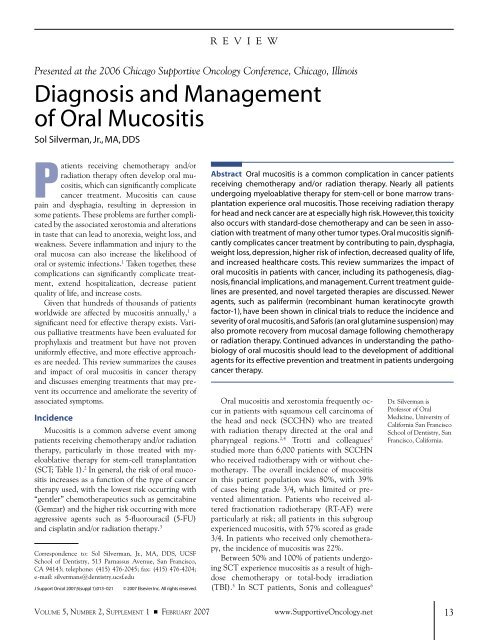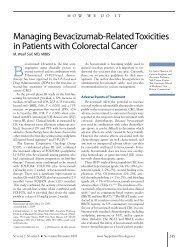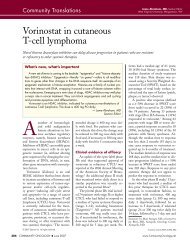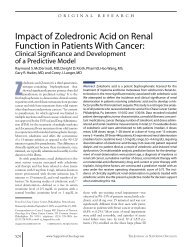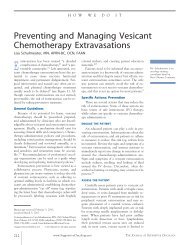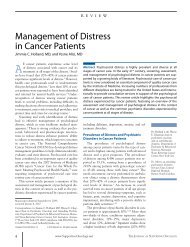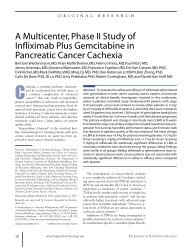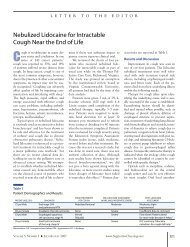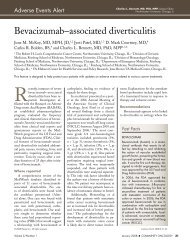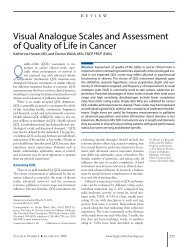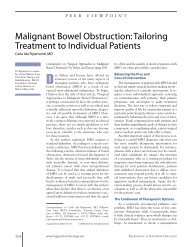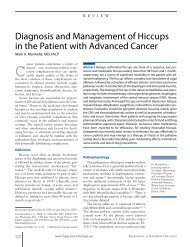Diagnosis and Management of Oral Mucositis
Diagnosis and Management of Oral Mucositis
Diagnosis and Management of Oral Mucositis
You also want an ePaper? Increase the reach of your titles
YUMPU automatically turns print PDFs into web optimized ePapers that Google loves.
R E V I E W<br />
Presented at the 2006 Chicago Supportive Oncology Conference, Chicago, Illinois<br />
<strong>Diagnosis</strong> <strong>and</strong> <strong>Management</strong><br />
<strong>of</strong> <strong>Oral</strong> <strong>Mucositis</strong><br />
Sol Silverman, Jr., MA, DDS<br />
P<br />
atients receiving chemotherapy <strong>and</strong>/or<br />
radiation therapy <strong>of</strong>ten develop oral mucositis,<br />
which can significantly complicate<br />
cancer treatment. <strong>Mucositis</strong> can cause<br />
pain <strong>and</strong> dysphagia, resulting in depression in<br />
some patients. These problems are further complicated<br />
by the associated xerostomia <strong>and</strong> alterations<br />
in taste that can lead to anorexia, weight loss, <strong>and</strong><br />
weakness. Severe inflammation <strong>and</strong> injury to the<br />
oral mucosa can also increase the likelihood <strong>of</strong><br />
oral or systemic infections. 1 Taken together, these<br />
complications can significantly complicate treatment,<br />
extend hospitalization, decrease patient<br />
quality <strong>of</strong> life, <strong>and</strong> increase costs.<br />
Given that hundreds <strong>of</strong> thous<strong>and</strong>s <strong>of</strong> patients<br />
worldwide are affected by mucositis annually, 1 a<br />
significant need for effective therapy exists. Various<br />
palliative treatments have been evaluated for<br />
prophylaxis <strong>and</strong> treatment but have not proven<br />
uniformly effective, <strong>and</strong> more effective approaches<br />
are needed. This review summarizes the causes<br />
<strong>and</strong> impact <strong>of</strong> oral mucositis in cancer therapy<br />
<strong>and</strong> discusses emerging treatments that may prevent<br />
its occurrence <strong>and</strong> ameliorate the severity <strong>of</strong><br />
associated symptoms.<br />
Incidence<br />
<strong>Mucositis</strong> is a common adverse event among<br />
patients receiving chemotherapy <strong>and</strong>/or radiation<br />
therapy, particularly in those treated with myeloablative<br />
therapy for stem-cell transplantation<br />
(SCT; Table 1). 2 In general, the risk <strong>of</strong> oral mucositis<br />
increases as a function <strong>of</strong> the type <strong>of</strong> cancer<br />
therapy used, with the lowest risk occurring with<br />
“gentler” chemotherapeutics such as gemcitabine<br />
(Gemzar) <strong>and</strong> the higher risk occurring with more<br />
aggressive agents such as 5-fluorouracil (5-FU)<br />
<strong>and</strong> cisplatin <strong>and</strong>/or radiation therapy. 3<br />
Correspondence to: Sol Silverman, Jr., MA, DDS, UCSF<br />
School <strong>of</strong> Dentistry, 513 Parnassus Avenue, San Francisco,<br />
CA 94143; telephone: (415) 476-2045; fax: (415) 476-4204;<br />
e-mail: silvermans@dentistry.ucsf.edu<br />
J Support Oncol 2007;5(suppl 1):013–021<br />
© 2007 Elsevier Inc. All rights reserved.<br />
Abstract <strong>Oral</strong> mucositis is a common complication in cancer patients<br />
receiving chemotherapy <strong>and</strong>/or radiation therapy. Nearly all patients<br />
undergoing myeloablative therapy for stem-cell or bone marrow transplantation<br />
experience oral mucositis. Those receiving radiation therapy<br />
for head <strong>and</strong> neck cancer are at especially high risk. However, this toxicity<br />
also occurs with st<strong>and</strong>ard-dose chemotherapy <strong>and</strong> can be seen in association<br />
with treatment <strong>of</strong> many other tumor types. <strong>Oral</strong> mucositis significantly<br />
complicates cancer treatment by contributing to pain, dysphagia,<br />
weight loss, depression, higher risk <strong>of</strong> infection, decreased quality <strong>of</strong> life,<br />
<strong>and</strong> increased healthcare costs. This review summarizes the impact <strong>of</strong><br />
oral mucositis in patients with cancer, including its pathogenesis, diagnosis,<br />
financial implications, <strong>and</strong> management. Current treatment guidelines<br />
are presented, <strong>and</strong> novel targeted therapies are discussed. Newer<br />
agents, such as palifermin (recombinant human keratinocyte growth<br />
factor-1), have been shown in clinical trials to reduce the incidence <strong>and</strong><br />
severity <strong>of</strong> oral mucositis, <strong>and</strong> Saforis (an oral glutamine suspension) may<br />
also promote recovery from mucosal damage following chemotherapy<br />
or radiation therapy. Continued advances in underst<strong>and</strong>ing the pathobiology<br />
<strong>of</strong> oral mucositis should lead to the development <strong>of</strong> additional<br />
agents for its effective prevention <strong>and</strong> treatment in patients undergoing<br />
cancer therapy.<br />
<strong>Oral</strong> mucositis <strong>and</strong> xerostomia frequently occur<br />
in patients with squamous cell carcinoma <strong>of</strong><br />
the head <strong>and</strong> neck (SCCHN) who are treated<br />
with radiation therapy directed at the oral <strong>and</strong><br />
pharyngeal regions. 2,4 Trotti <strong>and</strong> colleagues 2<br />
studied more than 6,000 patients with SCCHN<br />
who received radiotherapy with or without chemotherapy.<br />
The overall incidence <strong>of</strong> mucositis<br />
in this patient population was 80%, with 39%<br />
<strong>of</strong> cases being grade 3/4, which limited or prevented<br />
alimentation. Patients who received altered<br />
fractionation radiotherapy (RT-AF) were<br />
particularly at risk; all patients in this subgroup<br />
experienced mucositis, with 57% scored as grade<br />
3/4. In patients who received only chemotherapy,<br />
the incidence <strong>of</strong> mucositis was 22%.<br />
Between 50% <strong>and</strong> 100% <strong>of</strong> patients undergoing<br />
SCT experience mucositis as a result <strong>of</strong> highdose<br />
chemotherapy or total-body irradiation<br />
(TBI). 5 In SCT patients, Sonis <strong>and</strong> colleagues 6<br />
Dr. Silverman is<br />
Pr<strong>of</strong>essor <strong>of</strong> <strong>Oral</strong><br />
Medicine, University <strong>of</strong><br />
California San Francisco<br />
School <strong>of</strong> Dentistry, San<br />
Francisco, California.<br />
VOLUME 5, NUMBER 2, SUPPLEMENT 1 ■ FEBRUARY 2007<br />
www.SupportiveOncology.net<br />
13
Table 1<br />
Incidence <strong>of</strong> <strong>Oral</strong> <strong>Mucositis</strong> Among Cancer Patients<br />
<strong>Diagnosis</strong> <strong>and</strong><br />
<strong>Management</strong> <strong>of</strong><br />
<strong>Oral</strong> <strong>Mucositis</strong><br />
INCIDENCE (%) GRADE 3/4 (%)<br />
Radiotherapy for head <strong>and</strong> neck cancer 85–100 25–45<br />
Stem-cell transplantation 75–100 25–60<br />
Solid tumors with myelosuppression 5–40 5–15<br />
Adapted from Trotti et al 2<br />
found that a higher oral mucositis rating correlated<br />
with an increased risk <strong>of</strong> significant infection,<br />
an increased number <strong>of</strong> days in the hospital,<br />
a greater use <strong>of</strong> opioids <strong>and</strong> total parenteral<br />
nutrition (TPN), higher healthcare costs, <strong>and</strong><br />
an elevated 100-day mortality rate. Other studies<br />
suggest that the severity <strong>of</strong> mucositis may be<br />
higher with allogeneic transplants than with autologous<br />
transplants. 6,7<br />
A smaller but still significant proportion <strong>of</strong> patients<br />
who receive st<strong>and</strong>ard-dose chemotherapy<br />
also develop mucositis as a result <strong>of</strong> therapy. A<br />
retrospective analysis 8 <strong>of</strong> oral <strong>and</strong> gastrointestinal<br />
(GI) mucositis in nearly 600 patients receiving<br />
myelosuppressive chemotherapy revealed that<br />
mucositis developed during 37% <strong>of</strong> 1,236 cycles <strong>of</strong><br />
chemotherapy. Episodes <strong>of</strong> bleeding were significantly<br />
more common during cycles with GI mucositis<br />
than during those without GI mucositis (13%<br />
vs 8%; P = 0.04), as were episodes <strong>of</strong> infection<br />
(73% vs 36%; P < 0.0001). After adjustments for<br />
other predictive factors, oral mucositis was found<br />
to be significantly correlated with infection (odds<br />
ratio [OR], 2.4; P < 0.0001), whereas GI mucositis<br />
was associated with both bleeding (OR, 2.0;<br />
P = 0.01) <strong>and</strong> infection (OR, 2.24; P < 0.0001).<br />
Of note, these authors projected that in patients<br />
with grade 3/4 mucositis <strong>and</strong> myelosuppression,<br />
an estimated 74.5% will develop infection, <strong>and</strong><br />
9.1% will die. 8 The risk <strong>of</strong> grade 3/4 oral or GI<br />
mucositis is significantly higher in patients with<br />
solid tumors treated with st<strong>and</strong>ard-dose chemotherapy<br />
who are myelosuppressed compared with<br />
all patients. Severe mucositis has been noted in<br />
association with the treatment <strong>of</strong> many types <strong>of</strong><br />
solid tumor, although the risk <strong>of</strong> grade 3/4 toxicity<br />
appears higher for patients with genitourinary<br />
cancer, lung cancer, <strong>and</strong> sarcoma. 8<br />
The clinical impact <strong>of</strong> oral mucositis was<br />
clearly evident in an analysis <strong>of</strong> patients with solid<br />
tumors who developed chemotherapy-induced<br />
myelosuppression. 8 Compared with patients who<br />
did not develop oral mucositis, those who did had<br />
higher rates <strong>of</strong> infection <strong>and</strong> antibiotic use (68%<br />
vs 36%), more weight loss (61% vs 54%), increased<br />
use <strong>of</strong> antiviral therapy (45% vs 10%) <strong>and</strong><br />
antifungal drugs (34% vs 6%), <strong>and</strong> more frequent<br />
chemotherapy dose reductions (25% vs 11%) <strong>and</strong><br />
delayed cycles (11% vs 9%).<br />
Economic Impact<br />
<strong>Mucositis</strong> <strong>and</strong> its treatment can have a significant<br />
economic impact. Patients incur increased<br />
costs for treatment, including in some cases hospitalization<br />
or emergency room visits for complications<br />
or life-threatening situations. In the previous<br />
retrospective analysis <strong>of</strong> patients who received<br />
myelosuppressive therapy with or without radiation<br />
therapy, the average cost for treating patients<br />
without oral mucositis was $3,893. In contrast,<br />
this figure nearly doubled to $6,618 in patients<br />
with grade 1/2 oral mucositis <strong>and</strong> rose to $9,458<br />
in those who developed grade 3/4 toxicity. 8 The<br />
overall incidence <strong>of</strong> mucositis-related hospitalization<br />
was 16% in three studies involving a total <strong>of</strong><br />
700 patients; the rate was highest in patients receiving<br />
RT-AF (32%). 2<br />
In a study <strong>of</strong> 92 patients undergoing SCT, severe<br />
GI mucositis associated with myelosuppressive or<br />
myeloablative therapy was found to lengthen hospitalization<br />
by an average <strong>of</strong> 2.6 days, increase the<br />
time on TPN <strong>and</strong> use <strong>of</strong> opioids, <strong>and</strong> add $25,405<br />
to the mean hospitalization cost compared with<br />
those without mucositis. 6 Total hospitalization<br />
costs increased as a function <strong>of</strong> severity <strong>of</strong> oral<br />
mucositis, as did the 100-day mortality rate.<br />
Similarly, Elting <strong>and</strong> colleagues 8 found that<br />
the mean length <strong>of</strong> hospitalization was 4 days, 6<br />
days, <strong>and</strong> 12 days during cycles with no mucositis,<br />
oral mucositis, <strong>and</strong> GI mucositis, respectively.<br />
As previously noted, oral mucositis may result in<br />
increased use <strong>of</strong> antibiotics <strong>and</strong> can cause dose<br />
reductions <strong>and</strong>/or delays in chemotherapy or radiotherapy.<br />
These results demonstrate that oral<br />
mucositis—particularly severe mucositis—is associated<br />
with increased healthcare utilization,<br />
significantly greater hospitalization <strong>and</strong> treatment<br />
costs, <strong>and</strong> higher mortality. Consequently, therapy<br />
designed to prevent its occurrence or accelerate<br />
its resolution should result in significant clinical<br />
benefit as well as healthcare cost savings.<br />
Pathogenesis<br />
Recent advances in underst<strong>and</strong>ing the pathobiology<br />
<strong>of</strong> oral mucositis suggest a complex, mul-<br />
14 www.SupportiveOncology.net THE JOURNAL OF SUPPORTIVE ONCOLOGY
A<br />
B<br />
C<br />
D<br />
Figure 1<br />
Clinical Appearance <strong>of</strong> <strong>Oral</strong> <strong>Mucositis</strong> in Patients With Cancer<br />
(A) <strong>Oral</strong> mucositis following radiation therapy. (B) In another patient, note mucosal lesions induced by radiation effects on an adjacent gold crown.<br />
(C <strong>and</strong> D) Neutropenic-associated grade 4 mucositis following myelosuppressive therapy in two patients. Inflammation <strong>and</strong> ulceration can be seen on the<br />
oropharynx in the left panel (C), <strong>and</strong> severe mucositis affecting the tongue is apparent on the right panel (D).<br />
tistep process. Sonis 9 has proposed a model to<br />
characterize the major steps in its development<br />
<strong>and</strong> resolution. In the initiation phase, reactive<br />
oxygen species (ROS) generated by exposure to<br />
chemotherapy or radiation therapy result in DNA<br />
str<strong>and</strong> breaks <strong>and</strong> damage to cells, tissues, <strong>and</strong><br />
blood vessels, which ultimately cause apoptosis.<br />
Such damage triggers activation <strong>of</strong> transcription<br />
factors such as nuclear factor kappa B (NF-κB),<br />
which in turn causes signaling <strong>and</strong> amplification<br />
through gene upregulation. Increasing levels <strong>of</strong><br />
cytokines like interleukin (IL)-1β <strong>and</strong> IL-6 trigger<br />
the initiation <strong>of</strong> various pathways that damage<br />
epithelial cells <strong>and</strong> surrounding fibroblasts. Proinflammatory<br />
cytokines, such as tumor necrosis factor<br />
alpha (TNF-α), further increase the activity<br />
<strong>of</strong> NF-κB, causing a feedback loop that promotes<br />
the cycle <strong>of</strong> inflammation, pain, <strong>and</strong> functional<br />
impairment. Penetration <strong>of</strong> the epithelium into<br />
the submucosa can occur in the ulceration phase,<br />
allowing colonization by oral bacteria <strong>and</strong> increasing<br />
the risk <strong>of</strong> sepsis. It is likely that each <strong>of</strong> these<br />
stages <strong>of</strong> mucositis pathogenesis occurs in a continuous,<br />
overlapping manner. Since each cycle<br />
<strong>of</strong> chemotherapy or radiation therapy is thought<br />
to trigger this cascade <strong>of</strong> events, this series <strong>of</strong> dynamic<br />
interactions likely occurs at different oral<br />
mucosa sites repeatedly during the course <strong>of</strong> cancer<br />
therapy. 9<br />
These models <strong>of</strong> the pathogenesis <strong>of</strong> oral<br />
mucositis have suggested a variety <strong>of</strong> potential<br />
therapeutic targets, which have resulted<br />
in the development <strong>of</strong> agents that can prevent<br />
or ameliorate associated symptoms (see section<br />
on “Targeted Therapies”). Several such<br />
compounds are thought to inhibit one or more<br />
Silverman<br />
VOLUME 5, NUMBER 2, SUPPLEMENT 1 ■ FEBRUARY 2007<br />
www.SupportiveOncology.net<br />
15
Table 2<br />
Updated Guidelines for <strong>Management</strong> <strong>of</strong> <strong>Oral</strong> <strong>Mucositis</strong><br />
CLINICAL PRACTICE<br />
steps in these pathways, thus enhancing their<br />
effectiveness. Since some agents act to downregulate<br />
NF-κB activation, which is involved in<br />
upregulating numerous genes encoding proinflammatory<br />
cytokines, the resulting inhibition<br />
may be greatly enhanced.<br />
<strong>Diagnosis</strong><br />
RECOMMENDATIONS<br />
Pain management • Regular oral pain assessment using validated selfassessment<br />
instruments<br />
• Topical anesthetics, other agents as needed<br />
<strong>Oral</strong> assessment <strong>and</strong> • Regular assessment using validated instruments<br />
oral care • Preventive <strong>and</strong> therapeutic oral care regimens<br />
• Routine, systematic oral hygiene<br />
• Interdisciplinary approach to oral care<br />
Dental care • Dental evaluation <strong>and</strong> treatment prior to initiating<br />
anticancer therapy (hygiene, teeth, periodontal)<br />
• Inclusion <strong>of</strong> dental pr<strong>of</strong>essionals as an integral part <strong>of</strong><br />
the interdisciplinary healthcare team<br />
General • Education <strong>of</strong> staff, patients, <strong>and</strong> families to ensure<br />
adherence to good oral care<br />
• Outcome assessment to improve quality <strong>of</strong> care<br />
Based on guidelines issued by the Basic <strong>Oral</strong> Care Group <strong>of</strong> the Multinational Association <strong>of</strong> Supportive Care in<br />
Cancer <strong>and</strong> International Society for <strong>Oral</strong> Oncology (MASCC/ISOO)<br />
Adapted from McGuire et al 17<br />
<strong>Diagnosis</strong> <strong>and</strong><br />
<strong>Management</strong> <strong>of</strong><br />
<strong>Oral</strong> <strong>Mucositis</strong><br />
<strong>Oral</strong> mucositis is typically diagnosed based on<br />
the clinical appearance, location, timing <strong>of</strong> oral lesions,<br />
<strong>and</strong> use <strong>of</strong> certain types <strong>of</strong> therapy known<br />
to be associated with mucositis. For example, stomatotoxic<br />
chemotherapeutics generally result in<br />
lesions on the unkeratinized movable mucosa, with<br />
less frequent involvement <strong>of</strong> the keratinized hard<br />
palate, dorsal surface <strong>of</strong> the tongue, or gingiva. 10<br />
Radiation therapy can also induce mucositis in a<br />
similar fashion. Representative examples <strong>of</strong> the appearance<br />
<strong>of</strong> oral mucositis are shown in Figure 1.<br />
Other common conditions can have a similar<br />
clinical presentation to oral mucositis <strong>and</strong> may<br />
confuse the differential diagnosis. They include<br />
oral c<strong>and</strong>idiasis (thrush), herpes simplex virus<br />
(HSV), <strong>and</strong> graft-versus-host disease (GVHD)<br />
in transplant patients (Figure 2). C<strong>and</strong>idal overgrowth<br />
(c<strong>and</strong>idiasis), which occurs in response to<br />
radiation therapy <strong>and</strong>/or chemotherapy, usually<br />
responds well to systemic antifungal medication.<br />
HSV is frequently seen in immunocompromised<br />
cancer patients receiving chemotherapy, 11 with<br />
lesions appearing on the lips (cold sores) or intraoral<br />
mucosa. 12 Initiation <strong>of</strong> antiviral therapy<br />
may ameliorate HSV-associated stomatitis <strong>and</strong><br />
reduce symptoms. <strong>Oral</strong> mucositis can also occur<br />
in patients receiving myeloablative conditioning<br />
regimens for allogeneic hematopoietic SCT <strong>and</strong> in<br />
those with GVHD, affecting the oral mucosa <strong>and</strong><br />
gingiva. 13 Consequently, accurate diagnosis <strong>of</strong> oral<br />
mucositis is critical to ensure selection <strong>and</strong> timely<br />
initiation <strong>of</strong> optimal therapy.<br />
Several scoring systems have been devised to<br />
assess the severity <strong>of</strong> oral mucositis <strong>and</strong> its treatment,<br />
but no one scale is uniformly employed. The<br />
two most common scales are those proposed by<br />
the World Health Organization (WHO) <strong>and</strong> the<br />
National Cancer Institute Common Toxicity Criteria<br />
(NCI–CTC). 10 Low grades (1 <strong>and</strong> 2) indicate<br />
a condition that allows dietary intake, whereas the<br />
more severe grades (3 <strong>and</strong> 4) limit or completely<br />
preclude the intake <strong>of</strong> solid food. In addition, Sonis<br />
et al 14 have devised an <strong>Oral</strong> <strong>Mucositis</strong> Assessment<br />
Scale (OMAS), which is more quantitative<br />
for clinical research but may be difficult to use in<br />
routine clinical care. Other scoring systems have<br />
been proposed, 15 but the lack <strong>of</strong> st<strong>and</strong>ardization<br />
has hampered their acceptance.<br />
Treatment<br />
TREATMENT GUIDELINES<br />
Treatment guidelines for oral mucositis were<br />
issued in 2004 16 <strong>and</strong> recently were updated by the<br />
Multinational Association <strong>of</strong> Supportive Care in<br />
Cancer <strong>and</strong> International Society for <strong>Oral</strong> Oncology<br />
(MASCC/ISOO). 17 Guidelines issued by the<br />
Basic <strong>Oral</strong> Care Group subcommittee reviewed<br />
32 relevant studies published in the literature between<br />
2000 <strong>and</strong> 2005. Discussions by the panel<br />
resulted in the development <strong>of</strong> a set <strong>of</strong> recommendations<br />
on the prevention <strong>and</strong> treatment <strong>of</strong> oral<br />
mucositis (Table 2).<br />
These guidelines emphasize basic oral care,<br />
an interdisciplinary approach to oral care, routine<br />
assessment <strong>of</strong> oral care <strong>and</strong> pain management<br />
using validated instruments, <strong>and</strong> regular<br />
dental assessment <strong>and</strong> dental care prior to the<br />
start <strong>of</strong> cancer therapy. Any irritants to the oral<br />
mucosa (eg, spicy foods or alcohol) should be<br />
avoided. The panel stressed the need for education<br />
<strong>of</strong> staff as well as patients <strong>and</strong> their families<br />
on proper oral care <strong>and</strong> the importance <strong>of</strong><br />
outcome assessment using quality-improvement<br />
processes.<br />
Currently, there is insufficient high-level<br />
16 www.SupportiveOncology.net THE JOURNAL OF SUPPORTIVE ONCOLOGY
A<br />
B<br />
C<br />
D<br />
E<br />
F<br />
Figure 2<br />
Differential <strong>Diagnosis</strong> <strong>of</strong> <strong>Oral</strong> <strong>Mucositis</strong><br />
<strong>Oral</strong> mucositis can resemble (A <strong>and</strong> B) c<strong>and</strong>idiasis (thrush), herpes simplex virus (HSV) on the palate (C) <strong>and</strong> oral-labial HSV in another immunosuppressed<br />
patient (D), <strong>and</strong> (E <strong>and</strong> F) graft-versus-host disease in two patients.<br />
evidence to recommend the use <strong>of</strong> bl<strong>and</strong> <strong>and</strong>/<br />
or medicated oral rinses for treatment <strong>of</strong> oral<br />
mucositis, although they may help to reduce<br />
the degree <strong>of</strong> gingivitis <strong>and</strong> plaque as well as<br />
the risk <strong>of</strong> caries. <strong>Mucositis</strong>-related pain should<br />
be carefully managed through the use <strong>of</strong> topical<br />
analgesics <strong>and</strong> nonsteroidal agents <strong>and</strong> patientcontrolled<br />
analgesia (opioids) for severe pain<br />
when necessary.<br />
PREVENTION OF RADIATION-<br />
INDUCED ORAL MUCOSITIS<br />
For patients receiving radiation therapy, use<br />
<strong>of</strong> mid-line radiation blocks <strong>and</strong> conformal radio-<br />
Silverman<br />
VOLUME 5, NUMBER 2, SUPPLEMENT 1 ■ FEBRUARY 2007<br />
www.SupportiveOncology.net<br />
17
<strong>Diagnosis</strong> <strong>and</strong><br />
<strong>Management</strong> <strong>of</strong><br />
<strong>Oral</strong> <strong>Mucositis</strong><br />
Incidence <strong>of</strong> oral mucositis (%)<br />
100<br />
80<br />
60<br />
40<br />
20<br />
0<br />
Figure 3<br />
Grade 0<br />
Grade 1<br />
Grade 2<br />
Grade 3<br />
Grade 4<br />
Palifermin<br />
(n = 106)<br />
Grade 2<br />
Grade 0<br />
Grade 3<br />
Grade 4<br />
Placebo<br />
(n = 106)<br />
Effect <strong>of</strong> Palifermin on the Incidence<br />
<strong>and</strong> Severity <strong>of</strong> <strong>Oral</strong> <strong>Mucositis</strong><br />
Patients with hematologic cancers undergoing intensive<br />
chemotherapy <strong>and</strong> radiotherapy in conjunction with stemcell<br />
transplantation were treated with palifermin or placebo.<br />
Palifermin-treated patients had a lower incidence <strong>of</strong> grade 3/4<br />
oral mucositis than did those who received placebo (P < 0.001).<br />
Copyright © 2004 Massachusetts Medical Society.<br />
All rights reserved. 42<br />
therapy (CRT) may help to prevent the occurrence<br />
<strong>of</strong> oral mucositis. Shielding <strong>of</strong> normal tissues with<br />
mid-line mucosa-sparing blocks may minimize<br />
acute radiation-induced toxicity. 18,19 In patients<br />
with advanced head <strong>and</strong> neck cancer, careful control<br />
<strong>of</strong> the radiation dose <strong>and</strong> volume using threedimensional<br />
(3D) CRT has not compromised tumor<br />
control but has decreased toxicity compared<br />
with st<strong>and</strong>ard radiotherapy. 20 Similarly, high-dose<br />
rate intraoperative radiation therapy (IORT) allows<br />
delivery <strong>of</strong> radiation directly to the tumor bed<br />
<strong>and</strong> thus may minimize radiation exposure to normal<br />
tissues <strong>and</strong> may reduce toxicities such as oral<br />
mucositis. 21 However, at the site <strong>of</strong> implantation,<br />
there is an increased risk for mucositis.<br />
A meta-analysis <strong>of</strong> r<strong>and</strong>omized clinical trials <strong>of</strong><br />
interventions designed to prevent oral mucositis<br />
induced by radiotherapy <strong>and</strong>/or chemotherapy<br />
was recently performed. 22 A total <strong>of</strong> 45 studies<br />
involving 8 different therapies were evaluated.<br />
Only four interventions demonstrated some protective<br />
effect on the development or severity <strong>of</strong><br />
oral mucositis: PTA (polymyxin E, tobramycin,<br />
<strong>and</strong> amphotericin B), with an OR <strong>of</strong> 0.61, granulocyte-macrophage<br />
colony-stimulating factor<br />
(GM-CSF; OR, 0.53), oral cooling (OR, 0.3),<br />
<strong>and</strong> amifostine (Ethyol; OR, 0.37). Additional<br />
approaches are clearly needed for more effective<br />
prevention <strong>and</strong> therapy.<br />
TARGETED THERAPIES<br />
A number <strong>of</strong> targeted therapies have recently<br />
been evaluated for prevention <strong>and</strong>/or treatment <strong>of</strong><br />
oral mucositis, including amifostine <strong>and</strong> other antioxidants,<br />
growth factors, cytokines, <strong>and</strong> glutamine.<br />
Amifostine. Amifostine is a radioprotectant<br />
that has been widely studied for prevention <strong>of</strong> oral<br />
mucositis induced by chemotherapy or radiation<br />
therapy. This agent is believed to act as a free radical<br />
scavenger, protecting against ROS generated<br />
by exposure to radiation. 23 Amifostine has been<br />
approved in the United States for reducing the incidence<br />
<strong>of</strong> severe xerostomia in patients with head<br />
<strong>and</strong> neck cancer associated with radiation therapy<br />
but has not been approved for oral mucositis. It<br />
has also been shown to protect against mucositis<br />
induced by treatment with epirubicin <strong>and</strong> gemcitabine<br />
24 <strong>and</strong> to reduce the incidence <strong>of</strong> severe<br />
(grade 3/4) oral mucositis in patients treated with<br />
chemoradiotherapy for head <strong>and</strong> neck cancer. 25<br />
Investigators <strong>of</strong> a r<strong>and</strong>omized phase III trial 26 <strong>of</strong><br />
303 patients with previously untreated head <strong>and</strong><br />
neck cancer who received radiation therapy found<br />
that amifostine reduced the incidence <strong>of</strong> ≥ grade<br />
2 acute xerostomia but had no effect on mucositis.<br />
Additionally, a recent meta-analysis 27 <strong>of</strong> 1,451<br />
cancer patients who received radiation therapy<br />
with amifostine demonstrated a statistically significant<br />
reduction in the risk <strong>of</strong> mucositis (OR,<br />
0.37; 95% confidence interval [CI], 0.29–0.48; P<br />
< 0.00001). However, adverse effects associated<br />
with amifostine, such as nausea, vomiting, hypotension,<br />
<strong>and</strong> allergic reactions, are significant <strong>and</strong><br />
can limit its clinical utility.<br />
Other Antioxidants. Given the encouraging activity<br />
seen with amifostine, other compounds that<br />
can inhibit ROS have been evaluated for protection<br />
against oral mucositis. Benzydamine hydrochloride<br />
can inhibit the production <strong>of</strong> inflammatory cytokines<br />
<strong>and</strong> may thus reduce mucosal damage due<br />
to radiation. Topical application <strong>of</strong> the antioxidant<br />
N-acetylcysteine (NAC) was found to reduce the<br />
severity <strong>of</strong> oral mucositis in animal models. 28 Use<br />
<strong>of</strong> an oral rinse containing benzydamine hydrochloride<br />
decreased the incidence <strong>of</strong> oral mucositis in a<br />
r<strong>and</strong>omized, placebo-controlled trial 29 <strong>of</strong> patients<br />
with head <strong>and</strong> neck carcinoma who received radiation<br />
therapy. Benzydamine hydrochloride also<br />
delayed use <strong>of</strong> analgesics when compared with pla-<br />
18 www.SupportiveOncology.net THE JOURNAL OF SUPPORTIVE ONCOLOGY
cebo. This agent has not yet been approved for use<br />
in the United States.<br />
Growth Factors. In some studies, use <strong>of</strong> hematopoietic<br />
colony-stimulating factors has resulted<br />
in a reduction in oral mucositis associated with<br />
cancer therapy. Kannan <strong>and</strong> colleagues 30 found<br />
that GM-CSF protected against radiation-associated<br />
mucositis in a study <strong>of</strong> 10 patients with head<br />
<strong>and</strong> neck cancer, but this effect was not seen in<br />
other studies. 31 In a r<strong>and</strong>omized trial, subcutaneous<br />
injection <strong>of</strong> GM-CSF in 29 patients undergoing<br />
radiotherapy for early-stage laryngeal cancer<br />
resulted in a decrease in the severity <strong>of</strong> mucositis,<br />
32 <strong>and</strong> similar results were observed in patients<br />
who were irradiated for oral <strong>and</strong> oropharyngeal<br />
tumors. 33 However, use <strong>of</strong> a mouthwash containing<br />
GM-CSF was not effective as prophylaxis for<br />
oral mucositis in cancer patients undergoing highdose<br />
chemotherapy with autologous SCT. 34<br />
Studies have indicated that granulocyte colony-stimulating<br />
factor (G-CSF) has generally<br />
shown less activity than GM-CSF in this regard.<br />
In eight lymphoma patients who received highdose<br />
methotrexate, G-CSF–based mouthwash<br />
decreased the severity <strong>of</strong> oral mucositis compared<br />
with placebo. 35 Yet another small study <strong>of</strong> patients<br />
receiving hyperfractionated radiation therapy saw<br />
no decrease in mucositis with use <strong>of</strong> G-CSF, although<br />
there were fewer treatment breaks. 36 Larger<br />
r<strong>and</strong>omized trials <strong>of</strong> these agents are needed to<br />
establish their efficacy in chemotherapy- or radiation<br />
therapy-induced oral mucositis.<br />
Cytokines. The pleiotropic cytokine IL-11 has<br />
been investigated to mitigate the mucotoxic effects<br />
<strong>of</strong> radiation therapy <strong>and</strong> chemotherapy <strong>and</strong><br />
has demonstrated activity in small animal models.<br />
14 In a phase II study, 37 IL-11 was administered<br />
to patients who received high-dose conditioning<br />
regimens <strong>and</strong> allogeneic SCT for hematologic malignancies.<br />
However, determination <strong>of</strong> the benefit<br />
<strong>of</strong> IL-11 was not possible due to the high mortality<br />
rate on this trial. Edema <strong>and</strong> cardiac arrhythmia<br />
are potential side effects <strong>of</strong> IL-11 therapy. 38<br />
Palifermin. Palifermin (Kepivance), or recombinant<br />
human keratinocyte growth factor-1, is<br />
another compound shown to reduce oral mucositis<br />
induced by radiation therapy <strong>and</strong> cytotoxic<br />
chemotherapy. Palifermin has multiple mechanisms<br />
<strong>of</strong> action, including downregulation <strong>of</strong> proinflammatory<br />
cytokines; inhibition <strong>of</strong> epithelial<br />
cell DNA damage <strong>and</strong> apoptosis; <strong>and</strong> stimulation<br />
<strong>of</strong> epithelial cell growth, differentiation, <strong>and</strong> migration.<br />
39 In murine models, palifermin treatment<br />
prior to chemoradiotherapy exerted a protective<br />
<strong>and</strong> trophic effect on the intestinal mucosa <strong>and</strong><br />
salivary gl<strong>and</strong>s. 40<br />
Clinical trials have demonstrated that palifermin<br />
can exert a mucoprotective effect in patients<br />
who were treated with chemotherapy or<br />
radiation therapy. A small study <strong>of</strong> 64 patients<br />
with metastatic colorectal cancer who received 5-<br />
FU/leucovorin demonstrated a lower incidence <strong>of</strong><br />
oral mucositis (grade 2 or higher) <strong>and</strong> less severe<br />
symptoms than did controls when palifermin was<br />
administered for 3 days prior to chemotherapy. 41<br />
In a study <strong>of</strong> 212 patients with hematologic<br />
cancers who received intensive chemoradiotherapy<br />
in conjunction with SCT, palifermin (60 µg/<br />
kg/d) was given for 3 consecutive days prior to the<br />
initiation <strong>of</strong> conditioning therapy <strong>and</strong> after autologous<br />
SCT. 42,43 Although palifermin significantly<br />
decreased the incidence <strong>of</strong> grade 3/4 oral mucositis<br />
(63% vs 98%; P < 0.001), the reduction in<br />
grade 4 oral mucositis was even more impressive<br />
(20% vs 62%; P < 0.001; Figure 3). Significant<br />
reductions were also achieved in the incidence <strong>of</strong><br />
mouth <strong>and</strong> throat soreness, use <strong>of</strong> opioid analgesics,<br />
<strong>and</strong> use <strong>of</strong> TPN. Moreover, decreased healthcare<br />
costs <strong>and</strong> improved quality <strong>of</strong> life were noted<br />
in this study. Palifermin-related adverse effects<br />
included skin toxicities (rash, erythema, edema,<br />
<strong>and</strong> pruritus), oral toxicities (dysesthesia, tongue<br />
discoloration, tongue thickening, dysgeusia), <strong>and</strong><br />
arthralgia. 44 Ongoing trials are further evaluating<br />
the ability <strong>of</strong> palifermin to reduce oral mucositis<br />
in patients receiving chemoradiotherapy for head<br />
<strong>and</strong> neck cancer <strong>and</strong> in the transplant setting.<br />
Glutamine. Many malignancies are characterized<br />
by decreased glutamine levels, which can be<br />
further exacerbated by cell damage caused by cancer<br />
therapy. Glutamine supplementation can reverse<br />
this effect <strong>and</strong> may help to protect mucosal<br />
tissues from damage by radiation therapy or chemotherapy<br />
<strong>and</strong> thus accelerate recovery. 45 Saforis<br />
(AES-14; glutamine combined with UpTec, an<br />
advance drug delivery system) was developed as a<br />
swish-<strong>and</strong>-swallow treatment for patients receiving<br />
chemotherapy or radiation therapy.<br />
An early trial <strong>of</strong> oral glutamine suspension was<br />
conducted in 21 women with metastatic breast<br />
cancer treated with high-dose paclitaxel <strong>and</strong> melphalan<br />
(Alkeran) as a conditioning regimen for<br />
autologous SCT. 46 Patients who used glutamine<br />
experienced a decrease in the severity <strong>and</strong> dura-<br />
Silverman<br />
VOLUME 5, NUMBER 2, SUPPLEMENT 1 ■ FEBRUARY 2007<br />
www.SupportiveOncology.net<br />
19
Patients (%) with WHO ≥ grade 2<br />
oral mucositis<br />
Figure 4<br />
50<br />
40<br />
30<br />
20<br />
10<br />
0<br />
Cycle 1<br />
∆ 11.0%<br />
P = 0.026<br />
Placebo<br />
AES-14<br />
Cycle 2<br />
∆ 17.8%<br />
P = 0.027<br />
Carryover Effect <strong>of</strong> Saforis in Phase III Trial <strong>of</strong> Patients<br />
With Breast Cancer Treated With Chemotherapy<br />
The 326 women who developed oral mucositis (grade ≥ 2) due to chemotherapy were<br />
r<strong>and</strong>omized to receive treatment with Saforis (2.5 g three times daily) or placebo for 14<br />
days. Saforis significantly reduced the incidence <strong>of</strong> oral mucositis compared with placebo<br />
in cycle 1. Patients who crossed over from Saforis to placebo in cycle 2 experienced a further<br />
reduction in the risk <strong>of</strong> mucositis compared, suggesting a carryover effect.<br />
Adapted from Peterson et al 47<br />
<strong>Diagnosis</strong> <strong>and</strong><br />
<strong>Management</strong> <strong>of</strong><br />
<strong>Oral</strong> <strong>Mucositis</strong><br />
tion <strong>of</strong> oral mucositis, with less need for parenteral<br />
morphine for pain relief.<br />
These results led to a placebo-controlled,<br />
crossover phase III trial that evaluated the ability<br />
<strong>of</strong> Saforis to reduce the incidence <strong>and</strong> severity <strong>of</strong><br />
oral mucositis in breast cancer patients receiving<br />
chemotherapy. 47 Of 2,084 patients treated with<br />
multiple cycles <strong>of</strong> 5-FU, doxorubicin, <strong>and</strong> cyclophosphamide,<br />
oral mucositis (WHO grade ≥ 2)<br />
developed in 326 women. This subset <strong>of</strong> patients<br />
was r<strong>and</strong>omized to treatment with Saforis (2.5 g<br />
three times daily) or placebo for 14 days following<br />
chemotherapy.<br />
Saforis reduced the incidence <strong>of</strong> oral mucositis<br />
(grade ≥ 2) by 22% compared with placebo<br />
(P = 0.026) as well as the duration (P = 0.048).<br />
In patients who crossed over from Saforis to the<br />
placebo arm in cycle 2, there was a suggestion <strong>of</strong><br />
a carryover effect, with a 36% reduction in the<br />
risk <strong>of</strong> mucositis compared with placebo alone<br />
(P = 0.027; Figure 4). There was no increase in<br />
the incidence <strong>of</strong> adverse effects related to Saforis<br />
treatment. These data suggest that this agent may<br />
be useful in preventing or reducing the incidence<br />
<strong>and</strong> severity <strong>of</strong> oral mucositis in patients undergoing<br />
cancer therapy.<br />
Conclusion<br />
<strong>Mucositis</strong> is a clinically important toxicity that<br />
is <strong>of</strong>ten encountered with cytotoxic chemotherapy<br />
or radiation therapy. Ulceration <strong>of</strong> the oral<br />
mucosa can impair patients’ ability to swallow<br />
<strong>and</strong> eat <strong>and</strong> may inhibit appetite, lengthen hospitalization<br />
<strong>and</strong> use <strong>of</strong> antibiotics, <strong>and</strong> increase<br />
the risk <strong>of</strong> infection from bacteremia. Moreover,<br />
healthcare costs associated with oral mucositis<br />
<strong>and</strong> its treatment can be substantial. Prompt, accurate<br />
diagnosis <strong>of</strong> oral mucositis by oncologists<br />
<strong>and</strong> initiation <strong>of</strong> prophylaxis <strong>and</strong> therapy are<br />
therefore essential.<br />
Although several preventive <strong>and</strong> therapeutic<br />
approaches have been evaluated, no single agent<br />
has been found to be superior. In some trials, free<br />
radical scavengers, such as amifostine <strong>and</strong> NAC,<br />
have reduced the severity <strong>of</strong> symptoms, but these<br />
agents have not yet been approved for treatment<br />
<strong>of</strong> oral mucositis in the United States. More recently,<br />
elucidation <strong>of</strong> the pathogenesis <strong>of</strong> mucositis<br />
<strong>and</strong> the cellular pathways underlying its<br />
development has suggested potential therapeutic<br />
targets. Significant reductions in the incidence<br />
<strong>and</strong> severity <strong>of</strong> oral mucositis have been observed<br />
in clinical trials <strong>of</strong> palifermin <strong>and</strong> the oral glutamine<br />
suspension Saforis. Continued evaluation <strong>of</strong><br />
these compounds, as single agents <strong>and</strong> in combination<br />
regimens, is ongoing, <strong>and</strong> they should improve<br />
treatment outcomes.<br />
References<br />
PubMed ID in brackets<br />
1. Duncan M, Grant G. <strong>Oral</strong> <strong>and</strong> intestinal mucositis—causes<br />
<strong>and</strong> possible treatments. Aliment<br />
Pharmacol Ther 2003;18:853–874. [14616150]<br />
2. Trotti A, Bellm LA, Epstein JB, et al. <strong>Mucositis</strong><br />
incidence, severity <strong>and</strong> associated outcomes in<br />
patients with head <strong>and</strong> neck cancer receiving radiotherapy<br />
with or without chemotherapy: a systematic<br />
literature review. Radiother Oncol 2003;66:253–262.<br />
[12742264]<br />
3. Peterson DE. New strategies for management<br />
<strong>of</strong> oral mucositis in cancer patients. J Support Oncol<br />
2006;4(suppl 1):9–13. [16499139]<br />
4. Dirix P, Nuyts S, Van den Bogaert W. Radiationinduced<br />
xerostomia in patients with head <strong>and</strong> neck<br />
cancer: a literature review. Cancer 2006;107:2525–<br />
2534. [17078052]<br />
5. Bellm LA, Epstein JB, Rose-Ped A, et al. Patient<br />
reports <strong>of</strong> complications <strong>of</strong> bone marrow transplantation.<br />
Support Care Cancer 2000;8:33–39. [10650895]<br />
6. Sonis ST, Oster G, Fuchs H, et al. <strong>Oral</strong> mucositis<br />
<strong>and</strong> the clinical <strong>and</strong> economic outcomes <strong>of</strong> hematopoietic<br />
stem-cell transplantation. J Clin Oncol<br />
2001;19:2201–2205. [11304772]<br />
7. Rapoport AP, Miller Watelet LF, Linder T, et al.<br />
Analysis <strong>of</strong> factors that correlate with mucositis in recipients<br />
<strong>of</strong> autologous <strong>and</strong> allogeneic stem-cell transplants.<br />
J Clin Oncol 1999;17:2446–2453. [10561308]<br />
20 www.SupportiveOncology.net THE JOURNAL OF SUPPORTIVE ONCOLOGY
8. Elting LS, Cooksley C, Chambers M, et al. The<br />
burdens <strong>of</strong> cancer therapy: clinical <strong>and</strong> economic<br />
outcomes <strong>of</strong> chemotherapy-induced mucositis.<br />
Cancer 2003;98:1531–1539. [14508842]<br />
9. Sonis ST. The pathobiology <strong>of</strong> mucositis. Nat Rev<br />
Cancer 2004;4:277–284. [15057287]<br />
10. Scully C, Sonis S, Diz PD. <strong>Oral</strong> mucositis. <strong>Oral</strong><br />
Dis 2006;12:229–241. [16700732]<br />
11. Tang IT, Shepp DH. Herpes simplex virus<br />
infection in cancer patients: prevention <strong>and</strong> treatment.<br />
Oncology (Williston Park) 1992;6:101–106,<br />
109. [1322152]<br />
12. Khan SA, Wingard JR. Infection <strong>and</strong> mucosal<br />
injury in cancer treatment. J Natl Cancer Inst Monogr<br />
2001;29:31–36. [11694563]<br />
13. Cutler C, Li S, Kim HT, et al. <strong>Mucositis</strong> after<br />
allogeneic hematopoietic stem cell transplantation:<br />
a cohort study <strong>of</strong> methotrexate- <strong>and</strong> nonmethotrexate-containing<br />
graft-versus-host disease<br />
prophylaxis regimens. Biol Blood Marrow Transplant<br />
2005;11:383–388. [15846292]<br />
14. Sonis ST, Eilers JP, Epstein JB, et al. Validation <strong>of</strong><br />
a new scoring system for the assessment <strong>of</strong> clinical<br />
trial research <strong>of</strong> oral mucositis induced by radiation<br />
or chemotherapy. <strong>Mucositis</strong> Study Group. Cancer<br />
1999;85:2103–2113. [10326686]<br />
15. Sonis ST, Elting LS, Keefe D, et al; <strong>Mucositis</strong><br />
Study Section <strong>of</strong> the Multinational Association for<br />
Supportive Care in Cancer; International Society for<br />
<strong>Oral</strong> Oncology. Perspectives on cancer therapy-induced<br />
mucosal injury: pathogenesis, measurement,<br />
epidemiology, <strong>and</strong> consequences for patients. Cancer<br />
2004;100(9 suppl):1995–2025. [15108222]<br />
16. Rubenstein EB, Peterson DE, Schubert M,<br />
et al; <strong>Mucositis</strong> Study Section <strong>of</strong> the Multinational<br />
Association for Supportive Care in Cancer; International<br />
Society for <strong>Oral</strong> Oncology. Clinical practice guidelines<br />
for the prevention <strong>and</strong> treatment <strong>of</strong> cancer therapyinduced<br />
oral <strong>and</strong> gastrointestinal mucositis. Cancer<br />
2004;100(suppl):2026–2046. [15108223]<br />
17. McGuire DB, Correa ME, Johnson J, Wien<strong>and</strong>ts<br />
P. The role <strong>of</strong> basic oral care <strong>and</strong> good clinical practice<br />
principles in the management <strong>of</strong> oral mucositis.<br />
Support Care Cancer 2006;14:541–547. [16775649]<br />
18. Ship JA, Eisbruch A, D’Hondt E, Jones RE. Parotid<br />
sparing study in head <strong>and</strong> neck cancer patients receiving<br />
bilateral radiation therapy: one-year results. J Dent<br />
Res 1997;76:807–813. [9109831]<br />
19. Perch SJ, Machtay M, Markiewicz DA, Kligerman<br />
MM. Decreased acute toxicity by using midline mucosa-sparing<br />
blocks during radiation therapy for carcinoma<br />
<strong>of</strong> the oral cavity, oropharynx, <strong>and</strong> nasopharynx.<br />
Radiology 1995;197:863–866. [7480771]<br />
20. Mantini G, Manfrida S, Cellini F, et al. Impact<br />
<strong>of</strong> dose <strong>and</strong> volume on radiation-induced mucositis.<br />
Rays 2005;30:137–144. [16294906]<br />
21. Hu K, Ship JA, Harrison LB. Rationale for integrating<br />
high-dose rate intraoperative radiation (HDR-<br />
IORT) <strong>and</strong> postoperative external beam radiation<br />
with subcutaneous amifostine for the management<br />
<strong>of</strong> stage III/IV head <strong>and</strong> neck cancer. Semin Oncol<br />
2003;30(suppl 18):40–48. [14727239]<br />
22. Stokman MA, Spijkervet FKL, Boezen HM,<br />
et al. Preventive intervention possibilities in radiotherapy-<br />
<strong>and</strong> chemotherapy-induced oral mucositis:<br />
results <strong>of</strong> meta-analyses. J Dent Res 2006;85:690–700.<br />
[16861284]<br />
23. Grdina DJ, Kataoka Y, Murley JS. Amifostine:<br />
mechanisms <strong>of</strong> action underlying cytoprotection<br />
<strong>and</strong> chemoprevention. Drug Metab Drug Interact<br />
2000;16:237–279. [11201306]<br />
24. Stokman MA, Wachters FM, Koopmans P, et al.<br />
Outcome <strong>of</strong> local application <strong>of</strong> amifostine (WR-1065)<br />
on epirubicin-induced oral mucositis: a phase II study.<br />
Anticancer Res 2004;24:3263–3267. [15510621]<br />
25. Antonadou D, Pepelassi M, Synodinou M,<br />
Puglisi M, Throuvalas N. Prophylactic use <strong>of</strong> amifostine<br />
to prevent radiochemotherapy-induced mucositis<br />
<strong>and</strong> xerostomia in head-<strong>and</strong>-neck cancer. Int J Radiat<br />
Oncol Biol Phys 2002;52:739–747. [11849797]<br />
26. Brizel DM, Wasserman TH, Henke M, et al. Phase<br />
III r<strong>and</strong>omized trial <strong>of</strong> amifostine as a radioprotector<br />
in head <strong>and</strong> neck cancer. J Clin Oncol 2000;18:3339–<br />
3345. [11013273]<br />
27. Sasse AD, Clark LG, Sasse EC, Clark OA.<br />
Amifostine reduces side effects <strong>and</strong> improves<br />
complete response rate during radiotherapy: results<br />
<strong>of</strong> a meta-analysis. Int J Radiat Oncol Biol Phys<br />
2006;64:784–791. [16198504]<br />
28. Blonder J, Etter J, Samaniegoet A, et al. Topical<br />
bioadhesive antioxidants reduce the severity <strong>of</strong><br />
experimental radiation induced oral mucositis. Proc<br />
Am Soc Clin Oncol 2001;20:1606.<br />
29. Epstein JB, Silverman S Jr, Paggiarino DA, et<br />
al. Benzydamine HCl for prophylaxis <strong>of</strong> radiationinduced<br />
oral mucositis: results from a multicenter,<br />
r<strong>and</strong>omized, double-blind, placebo-controlled trial.<br />
Cancer 2001;92:875–885. [11550161]<br />
30. Kannan V, Bapsy PP, Anantha N, et al. Efficacy<br />
<strong>and</strong> safety <strong>of</strong> granulocyte macrophage-colony<br />
stimulating factor (GM-CSF) on the frequency <strong>and</strong><br />
severity <strong>of</strong> radiation mucositis in patients with head<br />
<strong>and</strong> neck carcinoma. Int J Radiat Oncol Biol Phys<br />
1997;37:1005–1010. [9169806]<br />
31. Tejedor M, Valerdi JJ, Arias F, et al.<br />
Hyperfractionated radiotherapy concomitant with<br />
cisplatin <strong>and</strong> granulocyte colony-stimulating factor<br />
(filgrastim) for laryngeal carcinoma. Cytokines Cell<br />
Mol Ther 2000;6:35–39. [10976537]<br />
32. McAleese JJ, Bishop KM, A’Hern R, Henk JM.<br />
R<strong>and</strong>omized phase II study <strong>of</strong> GM-CSF to reduce<br />
mucositis caused by accelerated radiotherapy<br />
<strong>of</strong> laryngeal cancer. Br J Radiol 2006;79:608–613.<br />
[16823067]<br />
33. Masucci G, Broman P, Kelly C, et al. Therapeutic<br />
efficacy by recombinant human granulocyte/monocyte-colony<br />
stimulating factor on mucositis occurring<br />
in patients with oral <strong>and</strong> oropharynx tumors treated<br />
with curative radiotherapy: a multicenter open r<strong>and</strong>omized<br />
phase III study. Med Oncol 2005;22:247–256.<br />
[16110136]<br />
34. Dazzi C, Cariello A, Giovanis P, et al. Prophylaxis<br />
with GM-CSF mouthwashes does not reduce frequency<br />
<strong>and</strong> duration <strong>of</strong> severe oral mucositis in<br />
patients with solid tumors undergoing high-dose<br />
chemotherapy with autologous peripheral blood<br />
stem cell transplantation rescue: a double blind,<br />
r<strong>and</strong>omized, placebo-controlled study. Ann Oncol<br />
2003;14:559–563. [12649101]<br />
35. Karthaus M, Rosenthal C, Huebner G, et al.<br />
Effect <strong>of</strong> topical oral G-CSF on oral mucositis: a<br />
r<strong>and</strong>omised placebo-controlled trial. Bone Marrow<br />
Transplant 1998;22:781–785. [9827976]<br />
36. Mascarin M, Franchin G, Minatel E, et al. The effect<br />
<strong>of</strong> granulocyte colony-stimulating factor on oral<br />
mucositis in head <strong>and</strong> neck cancer patients treated<br />
with hyperfractionated radiotherapy. <strong>Oral</strong> Oncol<br />
1999;35:203–208. [10435157]<br />
37. Antin JH, Lee SJ, Neuberg D, et al. A phase I/II<br />
double-blind, placebo-controlled study <strong>of</strong> recombinant<br />
human interleukin-11 for mucositis <strong>and</strong> acute<br />
GVHD prevention in allogeneic stem cell transplantation.<br />
Bone Marrow Transplant 2002;29:373–377.<br />
[11919725]<br />
38. Smith JW 2nd. Tolerability <strong>and</strong> side-effect pr<strong>of</strong>ile<br />
<strong>of</strong> rhIL-11. Oncology (Williston Park) 2000;14(suppl<br />
8):41–47. [11033837]<br />
39. Blijlevens N, Sonis S. Palifermin (recombinant<br />
keratinocyte growth factor-1): a pleiotropic growth<br />
factor with multiple biological activities in preventing<br />
chemotherapy- <strong>and</strong> radiotherapy-induced mucositis.<br />
Ann Oncol 2006; advance access published on October<br />
9, 2006; doi:10.1093/annonc/mdl332. [17030544]<br />
40. Borges L, Rex KL, Chen JN, et al. A protective<br />
role for keratinocyte growth factor in a murine model<br />
<strong>of</strong> chemotherapy <strong>and</strong> radiotherapy-induced mucositis.<br />
Int J Radiat Oncol Biol Phys 2006;66:254–262.<br />
[16904525]<br />
41. Rosen LS, Abdi E, Davis ID, et al. Palifermin<br />
reduces the incidence <strong>of</strong> oral mucositis in patients<br />
with metastatic colorectal cancer treated with<br />
fluorouracil-based chemotherapy. J Clin Oncol<br />
2006:24:5194–5200. [17075109]<br />
42. Spielberger R, Stiff P, Bensinger W, et al.<br />
Palifermin for oral mucositis after intensive therapy<br />
for hematologic cancers. N Engl J Med 2004;351:2590–<br />
2598. [15602019]<br />
43. Stiff PJ, Emmanouilides C, Bensinger WI, et<br />
al. Palifermin reduces patient-reported mouth <strong>and</strong><br />
throat soreness <strong>and</strong> improves patient functioning in<br />
the hematopoietic stem-cell transplantation setting.<br />
J Clin Oncol 2006;24:5186–5193. [16391299]<br />
44. Siddiqui MA, Wellington K. Palifermin: in<br />
myelotoxic therapy-induced oral mucositis. Drugs<br />
2005;65:2139–2146. [16225371]<br />
45. Savarese DM, Savy G, Vahdat L, Wischmeyer<br />
PE, Corey B. Prevention <strong>of</strong> chemotherapy <strong>and</strong> radiation<br />
toxicity with glutamine. Cancer Treat Rev<br />
2003;29:501–513. [14585260]<br />
46. Cockerham MB, Weinberger BB, Lerchie SB.<br />
<strong>Oral</strong> glutamine for the prevention <strong>of</strong> oral mucositis<br />
associated with high-dose paclitaxel <strong>and</strong> melphalan<br />
for autologous bone marrow transplantation. Ann<br />
Pharmacother 2000;34:300–303. [10917373]<br />
47. Peterson DE, Jones JB, Petit RG. R<strong>and</strong>omized,<br />
placebo-controlled trial <strong>of</strong> Saforis for prevention <strong>and</strong><br />
treatment <strong>of</strong> oral mucositis in breast cancer patients<br />
receiving anthracycline-based chemotherapy. Cancer<br />
2007;109:322–331. [17154160]<br />
VOLUME 5, NUMBER 2, SUPPLEMENT 1 ■ FEBRUARY 2007<br />
www.SupportiveOncology.net<br />
21


